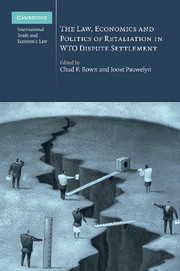Book contents
- Frontmatter
- Contents
- List of tables and figures
- Contributors
- Introduction: trade retaliation in WTO dispute settlement: a multi-disciplinary analysis
- PART I Background and goal(s) of WTO retaliation
- PART II A legal assessment after ten arbitration disputes
- PART III An economic assessment after ten arbitration disputes
- PART IV The domestic politics and procedures for implementing trade retaliation
- PART V Problems and options for reform
- 15 Evaluating the criticism that WTO retaliation rules undermine the utility of WTO dispute settlement for developing countries
- 16 Optimal sanctions in the WTO: the case for decoupling (and the uneasy case for the status quo)
- 17 Sanctions in the WTO: problems and solutions
- 18 WTO retaliatory measures: the case for multilateral regulation of the domestic decision-making process
- 19 The WTO Secretariat and the role of economics in panels and arbitrations
- 20 The equivalence standard under Article 22.4 of the DSU: a ‘tariffic’ misunderstanding?
- PART VI New frontiers and lessons from other fields
- Index
17 - Sanctions in the WTO: problems and solutions
Published online by Cambridge University Press: 26 February 2010
- Frontmatter
- Contents
- List of tables and figures
- Contributors
- Introduction: trade retaliation in WTO dispute settlement: a multi-disciplinary analysis
- PART I Background and goal(s) of WTO retaliation
- PART II A legal assessment after ten arbitration disputes
- PART III An economic assessment after ten arbitration disputes
- PART IV The domestic politics and procedures for implementing trade retaliation
- PART V Problems and options for reform
- 15 Evaluating the criticism that WTO retaliation rules undermine the utility of WTO dispute settlement for developing countries
- 16 Optimal sanctions in the WTO: the case for decoupling (and the uneasy case for the status quo)
- 17 Sanctions in the WTO: problems and solutions
- 18 WTO retaliatory measures: the case for multilateral regulation of the domestic decision-making process
- 19 The WTO Secretariat and the role of economics in panels and arbitrations
- 20 The equivalence standard under Article 22.4 of the DSU: a ‘tariffic’ misunderstanding?
- PART VI New frontiers and lessons from other fields
- Index
Summary
This brief contribution on sanctions in the WTO attempts to do three things. First, it overviews the current state of compliance with WTO dispute settlement decisions in order to set the stage for considering how important effective sanctions are to the successful operation of that system. Second, it comments on chapter 16 by Professor Sykes, above and proposes an alteration to the current system of sanctions. Third, it discusses several topics relevant to the calculation and implementation of sanctions in specific cases. The issues treated are: (1) timing considerations; (2) the use of counterfactuals to set the level of sanctions; (3) the use of so-called carousel provisions; (4) causation issues; and (5) how to handle changed circumstances, such as a claim that the violation has been corrected after the sanctions were imposed.
Compliance in WTO dispute settlement: how much of a problem? What role for sanctions?
Overall, the WTO dispute settlement system has an excellent compliance record. An examination of the implementation record for the first 10 years of WTO dispute settlement found a compliance rate of 83 percent. That is an impressive record, but it does not consider the quality and timeliness of compliance. The idea of “quality” of compliance concerns the extent to which the complainant obtained useful redress for the violation as a result of compliance. This is an issue because in certain kinds of cases compliance occurs, but may not be very meaningful.
- Type
- Chapter
- Information
- Publisher: Cambridge University PressPrint publication year: 2010
- 1
- Cited by



